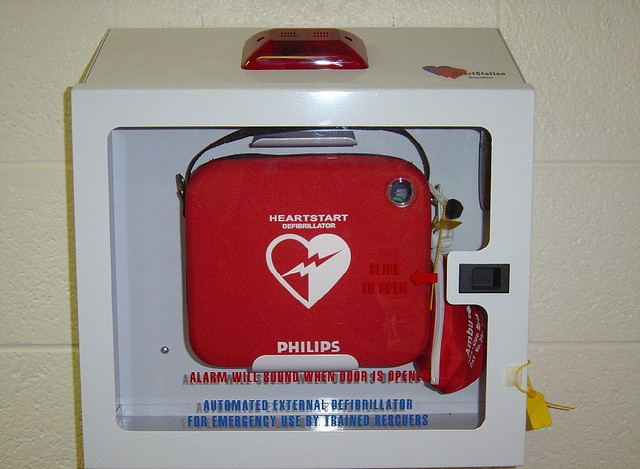
An Automated External Defibrillator (AED) is not an Implantable Cardiac Device (ICD)
You may have seen them in sports clubs, bars and public transit locations. Unlike an ICD (implantable cardioverter defibrillator), which have been known to keep a person alive even as the body is dying.
AEDs Automated External Defibrillator) are external devices that are applied at the discretion of the first responder. If an individual during end of life, who does not want to be resuscitated, dies, those around him or her should respect their wishes and not administer an AED shock. That being said, if the individual isn’t ready to kick the bucket, then an AED is their best chance of survival.
Sudden Cardiac Arrest – a heart attack – is a silent killer in an othewise healthy body
An AED administers shock to a person experiencing cardiac arrest. The process of applying electric shock to a person suffering cardiac arrest is known as defibrillation. The shock may help the person re-establish his normal heartbeat and can increase the chances of survival. An AED unit is housed in a portable case that contains electrode pads and other equipment. It also contains illustrations of where to place the pads and guides the rescuer with concise and easy-to-understand voice prompts.
How It Works
Once you turn on the machine, voice prompts will guide you through the defibrillation process. After wiping dry the whole chest area of the victim, apply the two electrode pads to the specific sections of the victim’s chest as indicated in the diagrams. Depending on the model of AED, you may need to plug the connector into the machine. The AED will analyze the victim’s heart rate. If a shock is needed, the machine automatically charges and instructs the rescuer to stand clear of the victim. A few models automatically deliver the shock. Others require the rescuer to press the shock button manually. CPR may need to be administered after the defibrillation until professional help arrives.
Who Should Use an AED?
Many professionals in the police, fire, EMT (Emergency Medical Teams) and medical departments are trained and re-certified in CPR and AED. However, people in other professions are also encouraged to learn CPR and how to use AEDs on children and adults. This knowledge can help assist victims until professional assistance arrives and it can help save lives. Classes are available through the Red Cross and other organizations.
Need for a policy
A few states and municipalities have instituted policies to guide the use of AEDs. It is a good idea for an organization using AEDs to have a policy with a clear goal of defining the responsibilities and protocols for application of the AEDs. An AED policy and procedure ought to address three main areas: system, personnel and equipment.
System
System includes not just the actual operation of the AED, but also rules for deciding when it should be used. AEDs are normally used on people who are unconscious, unresponsive, and not breathing with no discernible heartbeat. Some AEDs are not designed to be used on children under 8 years old, or people weighing less than 90 lbs. You should indicate if your unit falls under these parameters. It is also important to have an AED certified professional to create a written protocol outlining the operation of the AED.
Personnel
You may also want a doctor to sign off on training in the correct utilization of AED. Your policy and strategy statement should clarify who is to be trained, how frequently the training will take place, and who will direct the training.
Any worker or volunteer may be trained to use AED. Many policies state that anyone who uses an AED in an attempt to save someone’s life is exempt from any liability. The Good Samaritan Protection Act exempts anyone trying to use AED to save life from liability.
You should also appoint someone to be in charge of your AED program. This person will keep records of who is trained and when, report any occurrences in which the equipment is used, as well as keep maintenance records for the machine.
Equipment
Your record should provide details of which machine was used, its location and establish protocols for maintenance, including how regularly the machine will be serviced, who will perform the maintenance and what they will do to maintain the device.
Automated External Defibrillators (AEDs) are used to administer electric shock to victims of cardiac arrest. With AEDs, a layperson can administer defibrillation to a sudden cardiac arrest victim quickly while awaiting the arrival of emergency responders.
THanks to Guest Blogger Jason Kane: a professional blogger who knows the importance of having an AED readily available and works to spread awareness of AEDs. He currently writes for AEDs Today, a leading supplier of automatic external defibrillators.
I had no idea that an AED can analyze heart rates and give instructions for a shock if necessary. My uncle would like to open a medical clinic and is interested in buying a defibrillator that is easy to use for training purposes. I’ll let him know that he should consider getting an AED that offers clear, automated instructions.
AEDs are designed to be as simple to use as possible so that anybody can save a life in the event of an emergency. You should be able to rely on the AED to make all the decisions for you and guide you through the process step by step, so defibrillator training isn’t compulsory.